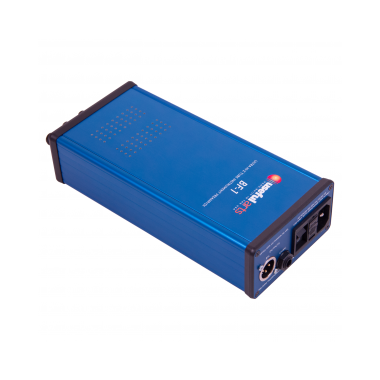- Flyline Music AG
Hauptmenü:
×
- index
-
Produkte
-
Mikrofone
-
3DIO
- Microphones
- Pro Microphones
- Accessoires
- AEA
- Antelope Audio
- Avantone Pro
- Bock Audio Design
-
Cascade Microphones
- Short Ribbons
- Long Ribbons
- Specialty Ribbons
- Accessoires
- Cloud Microphones
- Chandler Limited
- Coles Electroacoustics
- Dizengoff Audio
-
Earthworks
- Vocal Series
- PianoMic Series
- Drum Series
- SR Series
- TC Series
- QTC Series
- Periscope Series
- Measurement Series
- Accessoires
- Ear Trumpet Labs
- Granelli Audio Labs
- Josephson
- Kahayan Pro Audio
- Luke Audio
- Manley Labs
- Mojave Audio
- Placid Audio
- Roswell Pro Audio
- Royer Labs
- Sontronics
- Stager Microphones
- Townsend Labs
- Vanguard Audio Labs
- Warm Audio
-
3DIO
-
Studio Equipment
- A Designs Audio
- ACME Audio
- AEA
- AMS Neve
- Analoguetube
-
Antelope Audio
- Discrete Synergy Core Interfaces
- Discrete Interfaces
- HDX & USB Interfaces
- Thunderbolt & USB Interfaces
- Stereo Converters
- Master Clocks
- Mic Preamps
- Monitor Controller
- API
- Asparion
- Audified
- Avalon Designs
-
BAE
- Guitar Tools
- 500 Series
- Deskop Mic Preamps
- Modules & 19"
- Bettermaker
- Big Bear Audio
- Black Box
-
Black Lion Audio
-
500 Series
- Modules
- Rack
-
Outboard
- Mic Preamps
- Compressors
- Studio Clocks
-
500 Series
-
BURL Audio
- B1 500 Series Modules
- B2 Bombers
- B26 Orca
- B32 Vancouver
- B16 Mothership
- B80 Mothership
-
Chandler Limited
- Abbey Road Series
- 500 Series
- Germanium Series
- Rack Mixer
- Guitar Pedals
-
Cranborne Audio
- Outboard
- Desktop
-
500 Series
- Modules
- Racks
- Crane Song
-
Daking
- Preamplifiers
- Compressors
-
Dangerous Music
- Converters
- Controller
- Router
- Summierer
- Outboard
- Dave Hill Designs
- Dizengoff Audio
-
Drawmer
- Monitor Controller
- Sound Protection
- 60ies / 70ies Series
- MXPro Series
- Gates & Compressors
- Digital Management
- Signal Splitters
- Signal Distribution
- Power Amplifier
- Earthworks
-
Elysia
- 500 Series Modules
- 19" Outboard
-
Empirical Labs
- 500 Series
- 19" Outboard
- Plug-In
- Flock Audio
-
Fredenstein
- MixCube
- HD Reference Preamps
-
500 Series
- Artistic Modules
- F600 Modules
- Racks
- Vintage Analog Series
- Outboard Equipment
- Metering
- Grace Design
- Great River Electronics
-
Heritage Audio
- RAM Series
- Elite Series
- 500 Series
- Table Top Series
- 19" Outboard
- Classic Series
- Highland Dynamics
-
IGS Audio
- 500 Series
-
19" Outboard
- Spring Reverb
- Compressors
- Equalizers
- Preamplifier
- Interphase Audio
-
Inward Connections
- 500 Series Modules
- 19" Outboard
- JDK Audio
-
Kahayan Pro Audio
- Summing Mixers
- Amp/Speaker Selectors
- Preamplifier
-
Kush Audio
- 500 Series Modules
- 19" Outboard
-
La Chapell Audio
- 500 Series Modules
- 1/2 19" Outboard
- 19" Outboard
-
Lindell Audio
- 500 Series Modules
- 500 Series Racks
-
Lisson Grove
- 19" Outboard
- Little Labs
- Locomotive Audio
-
Looptrotter
- 500 Series Modules
- Outboard Equipment
- Modular Console
- Mäag Audio
-
Manley
- Mic Pres / Combos
- Equalizers
- Dynamics
- Maselec
-
Mercury Recording Equipment
-
500 Series
- Modules
- Racks
- Power Supplies
- Accessoires
- Vacuum Tube Outboard
- Solid State Outboard
- Custom Shop Outboard
-
500 Series
- Millennia
-
Mytek Digital
- Brooklyn Series
- Converters
- Private Q2
-
Overstayer
- 19" Outboard
- Pete's Place Audio
-
Phoenix Audio
- Desktop
- 500 Series
- 19" Outboard
- 1/2 19" Outboard
- Pultec
-
Purple Audio
- MFTwenty5 Rack Mixer
- 500 Series
- 19" Outboard
- Q2 Audio
-
Retro Instruments
- 500 Series Modules
- Portable Amplifier
- Outboard Equipment
-
Roger Schult
- 500 Series Modules
- 19" Outboard
-
Power Supplies
- Roll Music Systems
- Rupert Neve Designs
-
Serpent Audio
- 500 Series Modules
- 19" Outboard
-
Shadow Hills Industries
- 500 Series
- 19" Outbaord
-
Solid State Logic
- Audio Interfaces
- Small Format Consoles
- 500 Series
- Analogue Processors
- X-Rack System
- Digital Equipment
- Speck Electronics
-
Spectra 1964
- 19" Outboard
- Desktop
- 500 Series
- Standard Audio
-
Teegarden Audio
- DI Boxes
- Mic Preamps
-
Teknosign
- Box Line
- Preamplifier
- Summing Mixers
- Power Conditioner
- Patchbays/Adapters
- Thermionic Culture
-
TK Audio
- 500 Series Modules
- 19" Outboard
- Tonelux
- Tube Tech
- UK Sound by BAE
-
Universal Audio
- UAD-2 Live Rack
- OX The Amp Top Box
- Audio Interfaces
- UAD-2 Accelerators
- Analog Hardware
- Useful Arts Audio
- Vertigo Sound
- Warm Audio
- Wave Distro
- Weight Tank
- WesAudio
- Whitestone Audio
-
Monitoring
- Auratone
- Avantone Pro
-
Aviom
- FUGU Speakers
- Livemix
- Unity Audio
-
Electronic Sound
-
Mode Machines
- 19" Equipment
- Desktop
- MIDI Tools
- Pedals
- Sequential
-
Studio Electronics
- Boomstar Modular Synthesizers
- Boomstar Modular Eurorack
- Boomstar Desktop Synthesizers
- 19" Analog Synthesizers
-
Vermona
- Modular Module
- Synthesizer
- Drums & Percussion
- Effektgeräte
-
WMD
- Effect Pedals
-
Eurorack Modules
- Aperture
- Arpitecht
- Arpitecht Triad
- Buffered Multiple
- Chimera
- Compressor
- DVCA
- Fracture
- Geiger Counter
- Invert Offset
- Metron
- Micro Hadron Collider
- MSCL
- MM Envelope
- MM Extension
- MM VCA
- Overseer
- Performance Mixer
- PM Mutes Expander
- PM Channels
- PDO MKII
- PDO Triple Bipolar VCA
- Pro Output
- QAAF
- SSM
- SSM Expand
- Synchrodyne
- Synchrodyne Expand
- TRSHMSTR
-
WMD / SSF Collaboration
- Monolith Synthesizer
- Eurorack Modules
-
Mode Machines
-
Accessoires
-
ATR
- MDS-36 Tapes
- Precision Analog Master Tapes
-
Bittree
- Dante Patchbays
- TT Patchbays
- XLR / Jack Patchbays
- TT Patch Cables
- Accessoires
- Cloud Microphones
-
Latch Lake
- micKing®
- Xtra Booms
- iOxbooms
- Parts
-
Pete's Place Audio
- Pan 60
- Recording The Masters
- Scott Liebers
-
Sterling Modular
-
Multistation
-
Plan Consoles
- Racking Systems
-
Multistation
-
Teknosign
- Power Conditioner
- Patchbays/Adapters
-
Vovox
- sonorus
- link
- initio / textura
- sonorus XL
-
Zaor Studio Furniture
-
ATR
-
Mikrofone
- News
- Preislisten
- Links
- Kontakt
Produkte > Studio Equipment > Useful Arts Audio > DI Boxen
Features
Modelle / Preise
Zubehör
Hersteller
BF-1
Instrument Preamp / DI Box
- Mono Instrumenten Preamp & DI Box
- Input Impedanz bei 20 MOhms
- Class A Röhren Vorverstärker
- 2 Band Equalizer
- Output Regler
- Lo oder Hi Gain Modes
- Pure Mode für HiFi Level Output
- Input und Thru Jacks auf Gerätefront
- Output XLR und Jack auf Rückseite
They say there are no "magic bullets" in sound - there are specific tools for specific purposes. And they're usually right.
Until now.
The BF-1 is an all-purpose interface for any instrument with a pickup that enhances clarity, detail, audibility and dynamics whether used between the instrument and amp, the instrument and a PA or recording device or all of these at the same time. Whatever you plug into it just sounds better. This isn't because the BF-1 changes the sound of the instrument - it's because it preserves it in a way that the input stage of an amplifier or a console simply can't. Once you feed your amp, console or converters a strong representation of what's actually coming out of your instrument, you'll be amazed at how good it really sounds. (It's been sounding this good all along, but now you can finally hear it!)
So let's get nerdy. The BF-1 was built for musicians who care about the sound of their instruments. It's meant to be used by musicians with a minimum of fuss in any environment. Just plug the instrument in, plug the BF-1 into the amp, and be amazed.
We usually think of DIs as utility boxes designed to get an XLR-compatible signal out an instrument. Necessary, perhaps -- but boring. The last thing anyone wants to spend money on. So what if we took the interface out of the realm of the boring and made it an indispensable part of the original sound? The BF-1 does just that.
The signal generated by magnetic pickups is beautiful, nuanced, detailed and incredibly weak. That's even more true of piezoelectric pickups. It's not just a question of the level of the signal (a voltage concept), it's a question of the power of the signal (a current concept). All amplifiers make the signal do actual work to drive the input stage. The problem is that the most delicate parts of the signal aren't capable of doing that work, and are forever lost. It's a form of Heisenberg's "observer principle" - when we observe a phenomenon, we necessarily alter it. The goal in getting the best sound out of an instrument is to observe the sound while avoiding unintentional alteration of it.
It boils down to input impedance. The higher the input impedance, the less work the signal has to do before it is safely amplified. Consoles and recording devices usually have an input impedance of around 10,000 ohms - way too low for a pickup. Plug a guitar or bass directly in and it sounds lifeless, small and completely lacking in detail and low end. With a piezo pickup, it sounds thin, buzzy and grating - like you spent a few grand on a kazoo. Guitar and bass amps have an input impedance of several hundred thousand ohms - a big improvement. Instruments sound bigger, fuller and more detailed. This is why the traditional approach for recording or live gigs has been to run the instrument into a DI for the console and back out to the amp. The normal DI replicates the input impedance of the amp, converts it into a signal the console can use, and all is well. Boring, but fine.
What if we looked at this differently? What if we made the pickup do even less work? What if instead of a few hundred thousand ohms we created an interface with 20 million ohms input impedance? Well, we did. And the results are astounding. Now we can observe even the tiniest details in the signal without ruining it, and pump the results out to an amp or console with the full detail in useable form. There's no reason to plug an instrument into anything else. The BF-1 can simultaneously drive an amp through its 1/4 ing output jack and a pro audio device via XLR. Everything sounds better.
It turns out that tubes are uniquely well-suited for this task, because they are inherently capable of creating ridiculously high input impedances. Passive DIs use transformers, which can't effectively create such high impedances. Active Dis use low-voltage FETs, which sound like .... transistors. And they usually offer input impedances far lower than a good tube stage anyway. But wait! You already have a tube amp - won't that do the trick? Nope. Amps use tubes as high gain stages, and that drastically lowers their input impedance. They benefit hugely from the BF-1. The BF-1 uses the input tube the same way as a tube microphone - to convert impedances without the high gain.
There are other tube DIs out there, sure. But most of them resemble a traditional tube amp input and give you a nice low impedance output for the console. We took a different approach that offers better sound and way more flexibility - all for a ridiculously low price in a package that's small and rugged enough to put in a gig bag and use every day.
Instead of stopping at massive impedance conversion, the BF-1 also offers a Class A tube preamp, a two-band EQ and dual outputs that can be used simultaneously for your amp and console. But we didn't stop there. Bypass the EQ, and you have a choice of low gain (much like a traditional DI) or high gain, which gives you the ability to go straight to the converters for pure high-fidelity line level recording with no other amplification needed.
For bass players, the BF-1 can actually eliminate the need for an amp altogether. Feed a console with the tubes in the BF-1 and it will sound better than any bass amp output you've ever heard. Crank the low band of the EQ, and say goodbye to the windows and drywall in the venue.
BF-1
Instrument Preamp / DI Box
Vovox 6.3202: sonorus protect A Instrumentenkabel, 3.5m
Vovox 6.0707: link protect A Instrumentenkabel, 3.5m
Vovox 6.0902: link direct S Mikrofonkabel, 3.5m
Teknosign Noise Buster: Netzfilter
Useful Arts Audio
Phoenix AT, USA
Useful Arts was born out of an aesthetic quest for vibrant, living sound straight from the source -- not merely a technically clean sound that needs enhancement after enhancement to speak in a mix. Back in the days when the U-47 was a commonly-used "standard" microphone, there were no "standard" preamps -- studios used hand-built consoles with custom tube preamps designed to capture the personality of the recording. In the same way, our hand-built products are designed to enhance dynamics and perceived tonal richness, not simply to make a small signal electrically bigger. We invite you to hear for yourself the difference that philosophy makes.
We hand-build Class A tube gear in the United States for recording professionals and musicians. We don't build "clones" of classic gear -- our designs are created from the ground up and thoroughly optimized to achieve specific sonic goals. We use circuit topologies inspired by some of the most treasured gear made during the 40s, 50s and 60s, coupled with modern design techniques to ensure reliability, compatability and feature sets that meet the needs of the digital age. This approach requires expensive, bulky and heavy components, but as a small company we don't have to cut corners to meet the rigid cost constraints of mass-produced brands. (We don't make washing machines or cell phones, nor do we report to those who do). Our engineering mandate is to create the best-sounding equipment possible, not to figure out how to get acceptable sound at a retail price point. The result is gear that captures the sound of microphones and instruments not only with clarity, but with beauty.
There is plenty of usable gear out there that will give reliable performance with amazing specs. So who needs yet another option? People who want their recordings and live performances to sound intimate and powerful without the need for further processing. Plugins can do incredible things, but they can't create raw data that isn't there. Our devices ensure that every nuance and every transient is translated in a way that excites the ear.
That's the art of sound.
Copyright 2017. All rights reserved.







